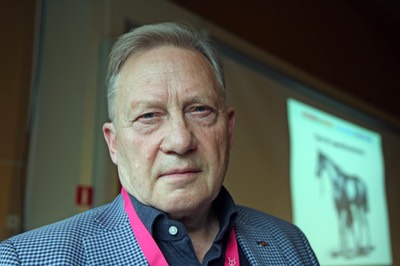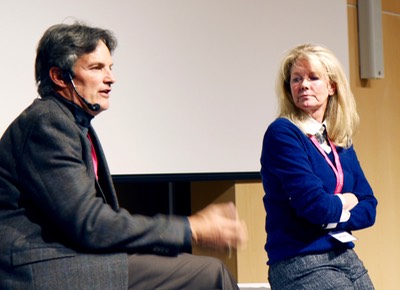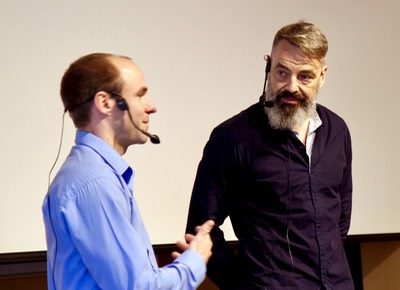Report and reflexion by Prof. Ulf Lindström
"Classic crosses, such as Star's Pride to mares by Hoot Mon, are less useful today as a key to the success of offspring at the track, leaving the breeders with discretion by individuals rather than bloodlines." - Staffan Philipsson.
"We're all served by having mentors." - Steve and Cindy Stewart.
"Cash And Go is faster than his full brother [Bold Eagle] in leaving the gate and over dashes of 300 meters." - Pierre Pilarski.
These observations and related topics were discussed as some eighty horsepeople came together Saturday and Sunday 27-28 October at the Solvalla racetrack in Stockholm. A sequel to the conference held two years ago, the organizers were again the Breeders' Association of Swedish Warmblooded Trotters (ASVT)* in cooperation with the federation of Swedish Trotting (ST).**
The participants were first offered a tour d'horizon of the breeding industry by Mr Staffan Philipsson. The trotter has made more progress than other breeds over the recent years for which comparative data are available. Over the years the population is becoming homogenous, reducing the spread and advancing the breed by 14/100 second per year. Consequently, "classic crosses" such as Star's Pride to mares by Hoot Mon, etc., are less useful as a key to the success of offspring at the track, leaving the breeders with discretion by individuals rather than bloodlines (cf., the advice by the Stewarts below).
Mr Philipsson sees the trotter taking a conformation that reminds of the
Thoroughbred, typically observed as prominent withers in both height
and length and the angle of the shoulder represented by Muscle Hill. Mr
Philipsson puts forth a possible source of this trait: the lengthening
of the humerus, the bone that connects the shoulder to the forearm
(scapula to radius). Furthermore of conformation details, some flaws
have been weeded out, to be supplanted by steadily improved parts that
may help the trotters run faster. Also, he pointed to details earlier
considered as flaws but now accepted as assets, like angeled hocks and
short backs. Cross-firing is now less common, a relief to line-gaited
trotters. By his own calculation drawn on 198 horses, forty-two percent
of the elite horses were "French broken," front leg turning outward from
carpus down. For Mr Philipsson's full presentation, an earlier English
edition, click right.
(Presentation Chart: Courtesy Staffan Philipsson.)
Mr Antonio Carrareto, prominent breeder of Italy, shared his views on the European and American industry, asking for improved cooperation also in cross-atlantic connections. He may be heard sooner than we've learned to expect from a sport nowhere nearly as dynamic as e.g., European football. With Mr JC Campbell taking the helm and calling for harmonization of the North-American industry, eyes will turn to the French federation to reconsider its protectionist policy (not imminent, though, cf., Mr Pilarski's comment below). Mr Carrareto was less impressed by Italian policy, sudden and short-term shifts, like premiums to breeders that were not helpful for the quality of the stock.
Mr and Mrs Steve and Cindy Stewart of Hunterton Farm, Kentucky (birthplace of i.a. Trixton and Mission Brief) presented their farm's background and policy on how to sell a champion. With 120 broodmares boarded and no resident stallions, Hunterton is recommending its clients to select from a broad supply of sires. As for turnover of the band of broodmares, the Stewarts suggested part ownership in order to afford top-shelf mares. Time consuming but rewarding advice to breeders: go visit plenty of farms, check out colts/fillies for size and conformation by pedigree, ask questions, take notes. "We're all served by having mentors." Also, the Stewarts reflected on cross-breeding to pacers, a questionable option since trotters are cutting their record time to become almost on par with the speed of pacers. For hands-on advice, the Stewarts mentioned feed, farriers and free undulating range for foals and yearlings to play, in addition to careful de-worming. (No mentioning of foal-imprinting, nota bene.) Ahead of sales, Hunterton takes care to coddle with the yearlings, talking to them, making them confident and happy.
A special treat was the live presentation and grading of the four stallions up for the Stallion Review Board: Broadway Hall (by Conway Hall), Monark Newmen (by Orlando Vici), Cruzado dela Noche (by Muscle Massive), and Villiam (by Muscle Hill). Mr Hakan Persson and associates briefed the attendants on the work of the Review Board, the criteria and scales used, after which the four stallions put on their best behavior in the auditorium, each one acknowledging the applause of the crowd as if there weren't anything called stage freight or test anxiety.***
The Sunday-morning session offered a (surprisingly) sprightly dialogue on how academic research may improve the breeding industry. Dr Asa Viklund of the Swedish School of Agriculture, Uppsala, presented the basic theory of breeding, including indicies such as the BLUP (Best Linear Unbiased Prediction). How to sustain the advance of our breed? Statistics, feed, health care? Earlier retirement of mares from racing, earlier retirement from breeding? Only, almost all kinds of improvement of the stock by case selection and retirement, once checked by the commercial realities, come with a paradox: increased inbreeding! The problem is that inbreeding of trotters (and pacers) is not taken as seriously as in other horse disciplines, let alone the dairy and beef industry as benchmark. Despite increased inbreeding, trotters are far from hitting the ceiling of record performances. Harness racing is a more complex discipline than thoroughbred racing, said to have stalled in speed as of the mid '70s. Trotters become faster also because new equipment is continuously introduced (and removed), racetrack engineers too respond to the quest for excellence, in addition to new insights in training programs - not to mention future concern among owners/trainers for the weight of the drivers.
Dr Viklund introduced the audience to genomic selection and GEBV, an industry acronym. Beyond what most laypersons (incl. your rapporteur) are able to grasp, it is a technique by which sampling selects the individuals already as foals to project further matings to produce the individuals most predisposed to succeed at the racetrack. If a reflection is allowed on her stellar presentation: embryo transfer already reality, no one honestly wants to go beyond to see cloned versions of the legends of our history, Greyhound, Permit, Frances Bulwark, Nevele Pride, Ozo, etc! Otherwise put, GEBV is not likely to make speedy inroads among the breeding community, as this technique simply takes away the thrill of the industry.# Used discriminantly, to prevent incurable disease, GEBV is altogether more welcome - if it stops with the preventive application.
The conference finale was a Q&A-session with Mr Pierre Pilarski, owner of Bold Eagle. Mr Pilarski was quite generous with both titbits - like how he came to acquire the horse, how Bold Eagle has released social-emotional characteristics in himself that he didn't know of before, why the full brother Cash And Go has lost time to injury and a screw in front carpus but is faster than his famous brother in leaving the gate and over dashes of 300 meters - and opinions on the state of the industry. Seconding Mr J-P Dubois' input at the previous conference, this included a frank view on the conservatism of the French in refusing to open the Studbook to the Standardbred.
At this time, however, the issue of the Studbook is pushed into the background. Concern for the opening of internet wagering in France is priority one. On-line betting is breaking the monopoly of the national tote PMU and causes uncertainty about the payback from gambling to the equine industry. In Mr Pilarski's summary of Gallic policy-making, it takes threats of "catastrophic dimensions" to change French minds in governance! Mr Pilarski confirmed that the 2018 campaigning of Bold Eagle has two races in view on top of everything else: the Prix d'Amerique in January and Elitloppet in May. As for breeding he hinted that there might be last-minute openings to Bold Eagle late in the season, in July.
* www.asvt.se
** www.travsport.se
***Result: https://www.travsport.se/article/2.292/1.652166
# Analogy drawn from academia: why are professors at world renowned
business schools still teaching for modest salaries instead of scoring
big-time as entrepreneurs? When will the faculties of the equine
departments of schools of agriculture rise to the challenge of breeding
the racehorses that earn more purse money and stud fees than commercial
players?
2017_11


